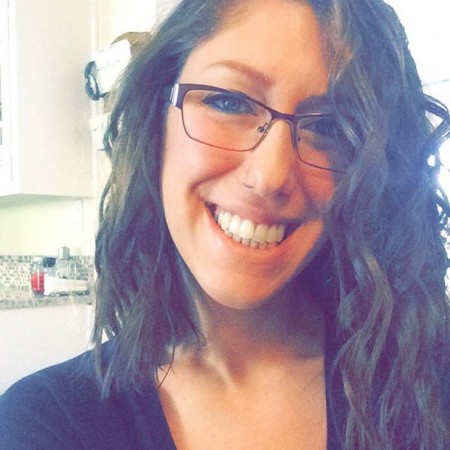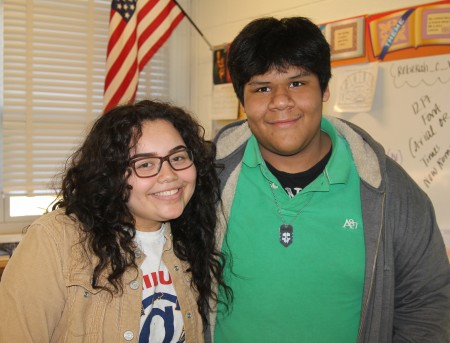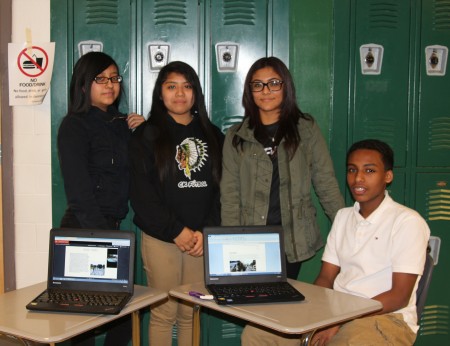On a recent Friday at Cross Keys High School, students in Rebekah Morris’s ninth-grade English class were studying something unusual: their own community along Buford Highway.
In the “Buford Highway Project,” 90 students are drafting their own visions for improving the rapidly redeveloping corridor’s safety, accessibility and quality of life. The top reports will be delivered to city governments that have official Buford Highway plans—most developed with little or no such input from residents of the famously diverse community along the road.

“I just wanted to make a real-world connection to , ‘Why do we need to read?’ ‘Why do we need to write?’ ‘Why do we need to make presentations?’” said Morris. “This is a real-world way to make them see, ‘My thoughts matter today.’”
Several students said the class project is eye-opening. They’re excited about some government ideas, like pedestrian safety fixes and the proposed Peachtree Creek Greenway park. Other ideas aren’t going over as well, such as Brookhaven’s 2014 study that called for rebranding the corridor as “Buford Boulevard” and replacing affordable apartments with “mixed-income” housing.
“Why are they going to change the name? We’ve been Buford Highway for so long,” said Lisa Sims, whose family lives on Clairmont Road. “Imagine your name is Jim and you change it to Tom. Everybody’s still going to call you Jim.”
“I live in Brookhaven…Every little chance they get, they tear something down” and replace it with houses her family couldn’t afford, Sims added.

“When I was younger, I used to live in those apartments. We didn’t have much money,” said Johnathan Vargas, summing up his concern: “How these people are making changes to our community and most of them don’t even live here.”
The Buford Highway Project assignment came out of Morris’s conversations with Marian Liou of We Love BuHi, a new program aiming to promote and preserve the corridor’s cultural diversity. Liou praised the class for improving community engagement in an immigrant community with “language and cultural barriers and perhaps a lack of a strong civic tradition.”
“I think empowering students to become active stakeholders in their own lives is especially important in areas like Buford Highway because they often mediate the world for their parents,” Liou said. “These students can take what they’ve learned home and share that enthusiasm and sense of ownership with their parents.”
Several students said language barriers are an issue for their parents, who speak Spanish or, for one student’s family, the Ethiopian language Amharic. With no translators available at most government meetings, that keeps their families home.
“Maybe they think no one would pay attention to their opinion because they don’t speak the language,” said Zujey Ramirez. “But I think they should [be included] because they’re the ones who live here.”
The students have no hesitation about sharing their opinions. As part of the project, some of them attended a recent Doraville City Council meeting to hear the city’s development plans and to share their own.
And the student visions, while still in rough draft form, are brimming with ideas. Architecture and the environment are focuses of one presentation, created by a team of students, including Leticia Arcila, Faysal Ando, Dinamis Roblero-Lopez, Cindy Ramirez and Zujey Ramirez. They call for a mix of modern architecture and antique stores, along with a local art museum.

More green space, trails and trees with decorative lighting are other ideas. Ando noted that many Buford Highway apartments are “like a forest” in the back, but have barren front yards. The students offer some ideas for fundraisers to pay for it all and solar panels to power it.
Ando also joined students Vladimir Castillo and Osmany Gaitan in a street safety plan. It’s personal for Ando, who lives on a stretch of Buford that has a dirt trail instead of a sidewalk. “I’ve almost gotten run over a couple times,” he said.
Most of the students said they would like to ride bikes on Buford, but are afraid to. Cindy Ramirez said she goes to Chamblee’s Dresden Park to ride her bike safely.
The students agreed that cultural diversity is their favorite thing about Buford Highway—and that their biggest worry is losing it to displacement and gentrification.
“Diversity, culture—I guess that’s what makes a community,” said Zujey Ramirez, raising Brookhaven’s proposal to redevelop apartment buildings. “I have questions, because what would happen to the people in the buildings right now? Would they be kicked out of their homes or placed in another city?”
“We need a plan to also keep people here,” said Roblero-Lopez.
As the students work on their proposals, Morris is arranging opportunities for them to share their ideas with elected officials, the Atlanta Regional Commission and activist groups like the MARTA Army. She also aims to hold an open house for parents, officials and the general public to view the final presentations.
Meanwhile, the students said that studying their changing community is already changing them. “It feels like doing something that will alter our lives,” Ando said.

I commend the teacher who engaged the students in this type of project about their community. Activism and community input is a hallmark of community planning, civic responsibility and a true neighborhood network. The student’s input shown in this article about public safety, street-scape, development ideas, greenspace and maintaining their authentic sense of their neighborhood are life long lessons that will stay with these students and support their community and future families. they are the very issues that the people, businesses and government officials at every level struggle with today in the Atlanta region and across the country. Bravo Ms. Morris and the students for this type of engagement.